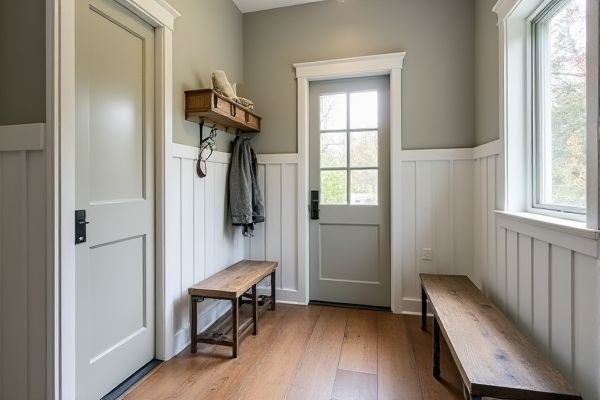
Traditional mudrooms often feature classic design elements like wooden cabinetry, earthy tones, and rustic details that create a warm, inviting space. Transitional mudrooms blend traditional charm with modern touches, offering a versatile and updated look perfect for Your home's evolving style. Explore the rest of the article to discover which mudroom design suits Your needs best.
Table of Comparison
| Feature | Traditional Mudroom | Transitional Mudroom |
|---|---|---|
| Design Style | Classic, ornate, detailed moldings and woodwork | Clean lines, blends classic and contemporary elements |
| Color Palette | Warm, rich tones like browns and deep reds | Neutral colors with soft accents like gray, beige, and white |
| Materials | Natural wood, stone, and vintage hardware | Mix of wood, metal, and modern composites |
| Storage Solutions | Built-in benches, cubbies, and lockers with decorative details | Minimalist open shelving, sleek cabinets, and multi-functional storage |
| Flooring | Durable hardwood or traditional tile patterns | Contemporary tiles or engineered wood with easy maintenance |
| Lighting | Chandeliers or vintage-style fixtures | Recessed or pendant lighting with clean design |
| Functionality | Emphasis on warmth and detailed decor | Focus on simplicity and practicality |
Understanding Traditional Mudrooms
Traditional mudrooms feature classic wood cabinetry, durable tile floors, and built-in benches with hooks for practical storage solutions. These spaces emphasize functionality while maintaining a warm, timeless aesthetic through natural materials and neutral color palettes. Your home benefits from a traditional mudroom's organized design, perfect for managing daily clutter and transitions between indoors and outdoors.
Defining Transitional Mudrooms
Transitional mudrooms blend classic design elements with modern functionality, offering a versatile and stylish space for managing everyday clutter. Unlike traditional mudrooms that emphasize rustic, utilitarian features, transitional mudrooms incorporate sleek lines, neutral color palettes, and updated materials to create a balanced and inviting entryway. Your home benefits from this adaptable style by combining practicality with aesthetic appeal, enhancing both organization and decor.
Key Design Elements of Traditional Mudrooms
Traditional mudrooms feature classic design elements such as built-in wooden benches, cubbies, and wainscoting, creating a warm and functional entryway. Natural materials like rich hardwood floors and vintage-inspired hardware enhance the timeless aesthetic. Your space benefits from practical storage solutions combined with elegant detailing, making it both welcoming and organized.
Core Features of Transitional Mudrooms
Transitional mudrooms blend classic design elements with modern functionality, featuring clean lines, neutral color palettes, and versatile storage solutions like built-in benches, cubbies, and sleek hooks. Core features include durable, easy-to-clean flooring materials such as tile or luxury vinyl, ample natural light, and thoughtfully integrated cabinetry that maximizes organization without overwhelming the space. Your transitional mudroom offers a practical yet stylish transition area that accommodates everyday needs while maintaining a timeless aesthetic.
Storage Solutions: Traditional vs. Transitional
Traditional mudrooms feature built-in wooden cubbies, sturdy benches, and vintage hooks enhancing rustic, functional storage, ideal for organizing heavy coats and boots. Transitional mudrooms combine contemporary sleek cabinetry with open shelving and minimalist hardware, offering versatile storage that blends aesthetics with practicality. Your choice depends on whether you prefer classic, cozy organization or modern, streamlined storage solutions.
Materials and Finishes Compared
Traditional mudrooms feature natural materials like rich wood cabinetry, stone or brick accents, and classic ceramic tile flooring, emphasizing warmth and timeless craftsmanship. Transitional mudrooms blend the rustic appeal of traditional wood with contemporary elements such as sleek metal hardware, neutral-toned porcelain tiles, and quartz countertops, creating a balanced, clean-lined aesthetic. The finishes in transitional designs often include matte or semi-gloss paint and mixed textures, contrasting with the heavier stain finishes and ornate details found in traditional spaces.
Color Palettes and Lighting Options
Traditional mudrooms often feature warm, earthy color palettes like deep browns, rich greens, and muted reds, creating a cozy and inviting atmosphere with classic sconces or vintage-inspired pendant lights. Transitional mudrooms blend neutral tones such as soft grays, whites, and beiges with modern fixtures like sleek recessed lighting or minimalist pendants to balance timeless elegance with contemporary brightness. Your choice between these styles influences the overall mood and functionality, with traditional lighting enhancing warmth and transitional options providing a clean, airy ambiance.
Functionality and Organization
Traditional mudrooms prioritize built-in cabinetry, cubbies, and hooks for storing coats, boots, and outdoor gear, maximizing functionality in a compact space. Transitional mudrooms blend these classic elements with modern storage solutions like sleek benches, open shelving, and multi-purpose compartments to enhance organization while maintaining aesthetic appeal. Your choice depends on whether you value timeless durability or contemporary versatility in managing daily clutter.
Style Compatibility with Home Architecture
Traditional mudrooms often feature classic elements such as wainscoting, vintage hooks, and built-in wooden benches that align seamlessly with historical or farmhouse-style homes. Transitional mudrooms blend traditional warmth with contemporary clean lines, neutral color palettes, and minimalist storage solutions, making them versatile for both modern and classic architectural styles. This fusion ensures the mudroom complements the home's overall design while providing functional, aesthetically balanced spaces.
Choosing the Right Mudroom Style for Your Home
Traditional mudrooms feature classic elements like wooden benches, built-in cubbies, and vintage hardware, offering a cozy, timeless aesthetic that complements rustic or farmhouse homes. Transitional mudrooms blend traditional warmth with modern clean lines, incorporating sleek storage solutions and neutral color palettes, ideal for homeowners seeking a versatile and updated look. Selecting the right mudroom style depends on your home's overall design, desired functionality, and personal taste, ensuring the space feels both practical and cohesive.
 homyna.com
homyna.com